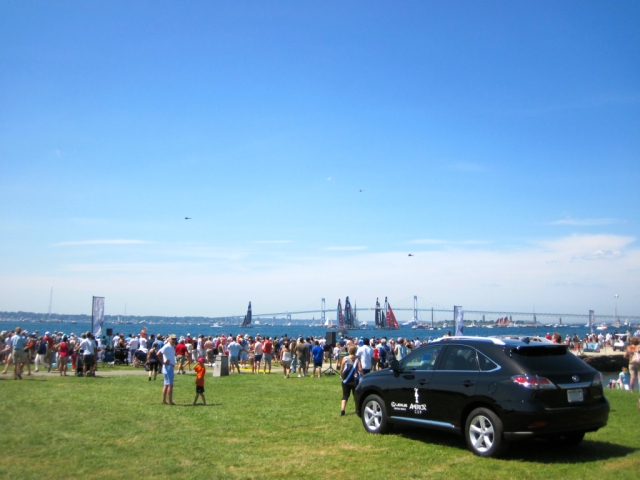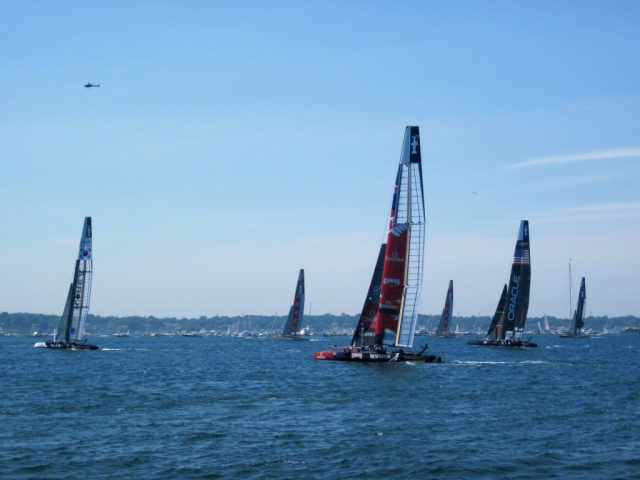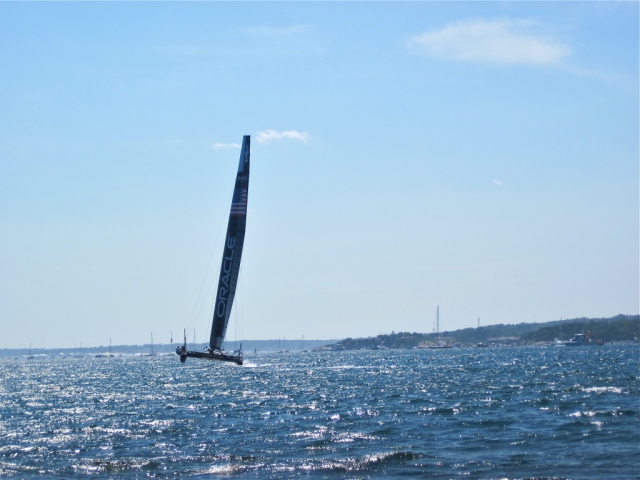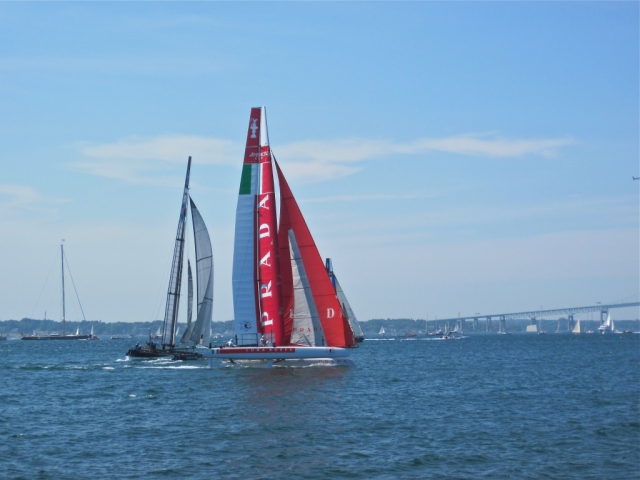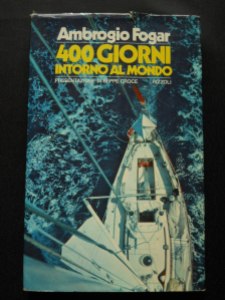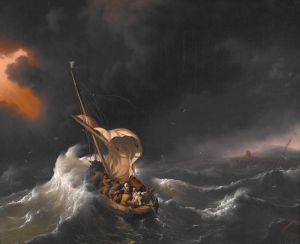
Sailing Solo Across the Atlantic Ocean – Part 1
I started filling the pages of this journal on the third day in the passage. I struggled in finding enough comfort to write while I adapted to every movement on the boat on the ever changing surface of the ocean. The first days are always a transition.
What follows are thoughts coming from my journal, quotes from the many books read and entries of the logbook I kept using my Inreach messenger. This device kept me in contact with loved ones and also allowed to keep a real-time tracking of my progress. Report of my past trips are still available on this page: https://share.garmin.com/sytranquility
Alone on a boat in the ocean I was still able to check on the people I love and they could see how I was doing (sailing wise). I also had access to the “weather council” a group of trustworthy people that kept an eye on me while feeding weather forecast and suggestions.
Toward the Azores
I left the St.Marys River in Georgia around noon on June 25. Light wind from WSW wasn’t the perfect forecast to lift anchor and go. It came the moment where I had to leave, no matter what. Land was keeping me as a prisoner and sometimes you just need that extra push start to something. Ocean journeys are no different.

The perk of this rushed departure is to start the long journey with an easy sail out of the inland waters, pushed by the ebbing tide along the placid turns of the river and out of Fernandina Inlet. I could even have a video call with Sara while the signal was still around. The downside is to endure few miles of bobbing around once out in the ocean swell as the light winds were not exerting sufficient pressure on my sails.
While I was adapting to the new reality the breeze increased and took me away from all the madness, complication and preoccupations of land pushing me toward the Gulf Stream.
Day 1 – 75nm covered- 3247nm to Faial – light WSW winds – sky overcast
Tranquility is doing good now that winds picked up. The tank I built is leaking. It is a bit upsetting as I spent a ton of time and money on it. The temptation of going into “shoulda, coulda oughta“ modality is strong but I let it go. It has no use to complain. Not anymore.
Sometimes doing less is doing more, and I tried to do more than necessary during this umpteenth boat refit. I tried to caulk the lower seam of the bulkhead where the water seeps out on the cabin sole, but of course it was not the best solution. When I am on a port tack the starboard locker gets wet and vice versa. I have to live with it.
I left with 250 liters of fresh water, so I can’t say I am in an emergency. The journey goes on and I have to care even more for the water I have left. Alone on board I already had a plan of not taking many showers.
Day3 – 104nm last 24h – Log 275nm- Moderate breeze WSW- on W wall of gulf stream- sunny – ocean very blue
I don’t usually eat a lot during the first days of an ocean journey. I try my best all the time, cooking dishes I can eat bit by bit as I feel like in a constant snacking mode. Now that I am far away from the coast what I do is sleeping a bit longer, reading a lot, sometimes watching a movie.
When I go to sleep I set an alarm to wake me up every 30 minutes so I can do a quick check on deck before going back to bed. I nap a lot during the day too in an effort not to be sleepy at night. Tranquility seems to take well care of herself as the windvane self steering keep her on course.
I had the plan of moving N aided by the Gulf Stream which flows steadily on a NNW course and to then cut WNW toward the Azores more or less at the height of Virginia, maybe even as far north as Delaware.
Persistent high pressure just off the Carolinas coast are making me me rethink this idea. A maze of puffing winds and squalls keep me busy without offering the reward of great progress toward destination. They are never too violent but I have to constantly ride them and when they are gone I am left with no winds in a confused sea.
Day 6 – 59nm last 24hrs – log 508nm – pushed SE by a squall line – broad reach – waiting for steady SWrlies
Liminal dreaming is very intense thanks to this schedule constant falling asleep and waking up. I am experimenting particularly with hypnagogia, the transition between wakefulness and sleep when bizarre and often insightful dreamy images appear. In this state dreaming doesn’t have the narrative character of the REM phase: It feels like a picture rather than a movie.
The journey proceeds well, I try to bend my mind to the tasks that keep me comfortable while Tranquility is sailing nicely and on course. I get focused on resting without trying to do much.
It feels like a meditation retreat, with no sangha and no masters, just my mind.
I realize I have the eyes bigger than my stomach. Some of the food I bought is rotting away as I don’t eat it fast enough, I don’t have very much appetite now. I set on a 2 meals per day routine.
Today I dunk the drone in the water, it happened at take off, so stupidly and abruptly that I could not avoid laughing and ask myself if that was a dream. So long for the drone. At take off the machine made an unexpected jerk back hitting the windpilot lines spinning out of control before crashing on the wind generator mast and dive in the ocean sinking rapidly some thousand meters underwater. So long to my aerial photography aspirations. I will stick to writing.
The wind, salt and sun are disinfecting me and the boat from land grime, dust and superfluous gadgets. My mind goes to the dehydrator too but for contrast it seems to be growing to embrace many parts, soaking and expanding in self examination. Many memories, ideas, doubts, any class of thoughts really pass through me as waves. I have little use for them but for acknowledging their presence.
Winds came back in spouts. During the early morning wind changed direction by 180 degrees already a couple of times, before settling on ESE and then gradually turning to S. As the wind increases the washing machine motion is coming back slowly, but I can handle it in return for good speed.
Wind is back since last night. Tranquility leaves just an ephemeral wake behind. I always found this image very poetic. Maybe leaving just a vanishing wake is the best way to sail through life, as we are but a temporary turbulence in the universe.

Day 9 – 79nm last 24hrs – Log 787nm – en route to Azores proceeding N of Depression 5
Depression 5 formed not far from my position, just to the SW. It is giving me a good sling shot effect to the NE bringing NW winds that propels me all afternoon and night. It is strengthening and now it’s been called Tropical Storm Edouard.
As Edouard is passing to the S of me the wind backs to WSW and I struggle to keep my heading to Azores. I have poled out the jib to starboard and secured the mainsail to port side. It seems to work well. The fading winds are keeping waves manageable with limited rolling.
“Modern neuroscience may show us that in fact the opposite is true—our true potential can only be realized through periods of doing nothing.“
Andrew Smart, Autopilot: the Art and Science of Doing Nothing
It is becoming very hard to reach 100 nautical miles in 24hr which is for me the bare minimum for a decent log entry. I should not be surprised. winds are usually scarce this time of the year in this area of the North Atlantic.
My mind can’t avoid to imagine how difficult it was for caravels and other ocean ships back in the age of discovery. They must have spent long days becalmed, stuck in the sargassum sea or in the Azores high, drifting under the weight of barnacles encrusted hulls.
Tranquility is an older design but her light air performance are not terrible compared to heavier cruising yachts. She has proved many times to be a good little vessel.
There is another downside of going so slow. The windvane is giving me trouble. When the boat speed falls below 2.5 knots the pressure on the underwater blade is not enough to engage and it creates a little play in the mechanism that aligns it with the wind blade. The movement of the stern on the ocean swell creates just enough momentum that the cogs slip and get misaligned. When that happen I can’t have the self-steering system behave properly.
With so little wind this mishap keeps recurring. It only takes the right wave and the two parts of the self steering get misaligned. When that happens I have to hang from the stern, push back one cog held in place by a spring, and jiggle the water blade tills it’s back in alignment. It is unnerving. The waves interfere with the rotation of the blade and I am afraid of falling overboard while precariously perked over the transom.
”The nocturnal brain is a Penelope unraveling the cloth of meaning diligently woven during the day.”
Olga Tokarczuk, Flights
The weather council communicated that more calm is expected for the next two days. I am not as concerned as before. For how much I want to arrive to destination, there is a convenient feeling about being in the middle of nowhere not doing so much. I am not racing, I don’t have a client to please and I am enjoying my time onboard. Time has ceased to be scarce, which makes me tackle serious reading. I nap constantly and in short bursts, still I can experience many dreams.
Day 12 – 89Nm last 24Hrs – LOG 1042Nm – becalmed
I also enjoy listening to music coming from the new speakers I installed when I built the hard-dodger. Dancing is the only activity I enjoy as a way to keep a decent muscular tone. And to be silly and feel alive to the point of being breathless and sweaty. It’s either that I am totally out of shape or that it is a really good work out. Hard to decide which is which. Middle of the Atlantic summer heat also plays a part.
To keep things interesting I can’t just constantly listen to music or music will lose its soothing quality. If I read too much I get distracted.
Writing poses its challenges too. I find it difficult to type on a moving boat. It is ok for short entries but it becomes extremely tiring to type for a long time, as I have to constantly keep my body upright despite all the acceleration it is subjected to. And I can’t type while lying down. Note to self: devise a writing station for ocean sailing.

I just had the best experience of the trip so far. All the lights were off on Tranquility, even navigation lights. While in the safety of the cockpit I raised my head to the sky and started to observe the stars. The breeze was pushing the boat along nicely at 4 knots on a flat sea and for one time Tranquility’s heading was perfectly en route with the imaginary line that connects where I am with the Azores.
The air is fresh and perfect: Tickling cool air on my bare skin, no bugs, no noise, no worries, just an infinte universe unfolding in front of my eyes and bioluminescence sparking in green dots all around Tranquility’s wake. I don’t have to do anything special to experience this moment. I don’t need to power a device, to open the pages of a book or to use any mind altering substance. The Universe above, the waves of the vast ocean and the life it contains are the perfect extension of my mind.
I walk to the bow to see the portion of the sky covered by the jib. There behind the canvas wing the milky way waited for me, rich and clear.
Suddenly two small dolphins out of nowhere arrive to join the party. I hear them jump in front of the bow and the blows from their spout. They produce a bioluminescent wake underwater and disappear as unexpectedly as they came. I have not seen a single dolphin in maybe a week or more and here, maybe a hundred miles north of Bermuda, on a flat Atlantic Ocean I realize that a single hour with my head up in the stars was the experience of a lifetime.
If all the time, money and effort spent were to experience that few hours with the head gazing at our beautiful and bizarre universe on a perfect sailing night, then I can affirm it was all worth it.
Of course moments like this happen constantly if we have the ability to forget our hindrances and desire and petty little problems and just face the wonderful miracle unfolding around us. For me getting as far as possible from everything did the trick, in collaboration with a lot of effort, tears, sweat and exchanges between in and out.
CLICK HERE FOR PART 2



















































